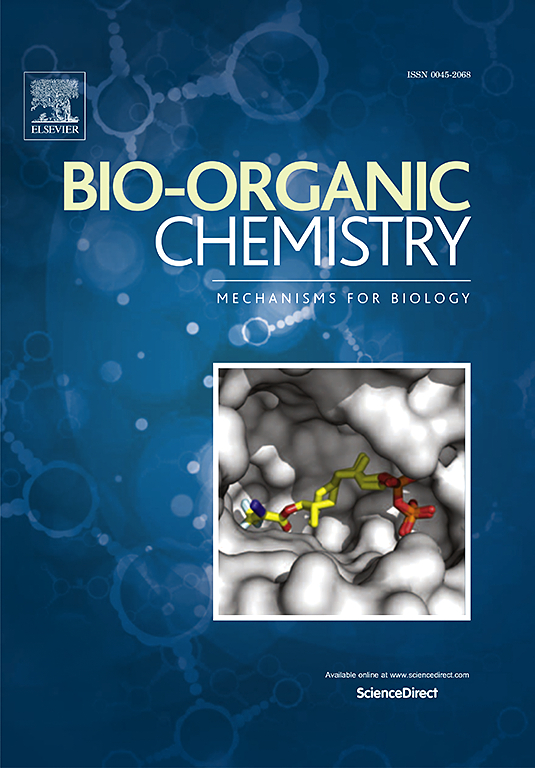小铲叶2-酰基吡咯类生物碱及其α-葡萄糖苷酶抑制活性研究
IF 4.5
2区 医学
Q1 BIOCHEMISTRY & MOLECULAR BIOLOGY
引用次数: 0
摘要
吡咯生物碱是一类具有独特结构和生物活性的天然产物。这些生物碱主要存在于龙爪属植物中。通过对小檗叶中吡咯类生物碱的研究,发现了具有生物活性的新型吡咯生物碱。本研究共鉴定出38种生物碱,包括21种新的吡咯生物碱(1 - 5、13、16、19 - 23、26 - 31、33、35和36),以及17种相关的类似物(6 - 12、14、15、17、18、24、25、32、34、37和38)。通过NMR、hresms、电子圆二色性(ECD)和x射线衍射分析对新化合物的结构进行了表征。值得注意的是,化合物28 - 31被鉴定为吡咯生物碱,具有前所未有的骨架。化合物28和29具有一个2-酰基吡咯生物碱和一个肉桂酸异二聚体,而30和31具有一个具有1,2-十六烷二醇片段的吡咯looxazinone支架。这些结构在植物中很少见。3个化合物(27、31和38)显示α-葡萄糖苷酶抑制活性。其中化合物27 (IC50: 320.3 μM)和31 (IC50: 153.7 μM)比阿卡波糖(IC50: 545.9 μM)的活性更强。分子对接研究表明,这三种生物活性化合物与α-葡萄糖苷酶蛋白具有较强的相互作用。此外,化合物27、31和38对HepG2细胞的葡萄糖消耗有显著的促进作用。本文章由计算机程序翻译,如有差异,请以英文原文为准。

2-Acylpyrrole-based alkaloids from the leaves of Sauropus spatulifolius and their α-glucosidase inhibitory activities
Pyrrole alkaloids are a class of natural products with intriguing structures and promising biological actives. Within the Sauropus plants, these alkaloids are mainly present in Sauropus spatulifolius. An investigation of the leaves of S. spatulifolius was conducted to discover novel and bioactive pyrrole alkaloids. This study led to the identification of 38 alkaloids, including 21 new pyrrole alkaloids (1 − 5, 13, 16, 19 − 23, 26 − 31, 33, 35, and 36), along with 17 related analogues (6 − 12, 14, 15, 17, 18, 24, 25, 32, 34 37, and 38). The structures of the new compounds were elucidated by NMR, HRESIMS, electronic circular dichroism (ECD), and X-ray diffraction analysis. Notably, compounds 28 − 31 were identified as pyrrole alkaloids with unprecedented skeletons. Compounds 28 and 29 featured a 2-acylpyrrole alkaloid and a cinnamic acid heterodimers, while 30 and 31 possessed a pyrrolooxazinone scaffold with a 1,2-hexadecanediol moiety. These structures were rare in plants. Three compounds (27, 31, and 38) displayed α-glucosidase inhibitory activity. Particularly, compounds 27 (IC50: 320.3 μM) and 31 (IC50: 153.7 μM) exhibited stronger activity than that of acarbose (IC50: 545.9 μM). Molecular docking studies showed the strong interactions of the three bioactive compounds with the α-glucosidase protein. Additionally, compounds 27, 31, and 38 showed significant effects on enhancing glucose consumption in HepG2 cells.
求助全文
通过发布文献求助,成功后即可免费获取论文全文。
去求助
来源期刊

Bioorganic Chemistry
生物-生化与分子生物学
CiteScore
9.70
自引率
3.90%
发文量
679
审稿时长
31 days
期刊介绍:
Bioorganic Chemistry publishes research that addresses biological questions at the molecular level, using organic chemistry and principles of physical organic chemistry. The scope of the journal covers a range of topics at the organic chemistry-biology interface, including: enzyme catalysis, biotransformation and enzyme inhibition; nucleic acids chemistry; medicinal chemistry; natural product chemistry, natural product synthesis and natural product biosynthesis; antimicrobial agents; lipid and peptide chemistry; biophysical chemistry; biological probes; bio-orthogonal chemistry and biomimetic chemistry.
For manuscripts dealing with synthetic bioactive compounds, the Journal requires that the molecular target of the compounds described must be known, and must be demonstrated experimentally in the manuscript. For studies involving natural products, if the molecular target is unknown, some data beyond simple cell-based toxicity studies to provide insight into the mechanism of action is required. Studies supported by molecular docking are welcome, but must be supported by experimental data. The Journal does not consider manuscripts that are purely theoretical or computational in nature.
The Journal publishes regular articles, short communications and reviews. Reviews are normally invited by Editors or Editorial Board members. Authors of unsolicited reviews should first contact an Editor or Editorial Board member to determine whether the proposed article is within the scope of the Journal.
 求助内容:
求助内容: 应助结果提醒方式:
应助结果提醒方式:


